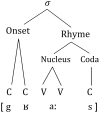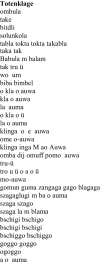Extracting salient sublexical units from written texts: "Emophon," a corpus-based approach to phonological iconicity
- PMID: 24101907
- PMCID: PMC3787248
- DOI: 10.3389/fpsyg.2013.00654
Extracting salient sublexical units from written texts: "Emophon," a corpus-based approach to phonological iconicity
Abstract
A GROWING BODY OF LITERATURE IN PSYCHOLOGY, LINGUISTICS, AND THE NEUROSCIENCES HAS PAID INCREASING ATTENTION TO THE UNDERSTANDING OF THE RELATIONSHIPS BETWEEN PHONOLOGICAL REPRESENTATIONS OF WORDS AND THEIR MEANING: a phenomenon also known as phonological iconicity. In this article, we investigate how a text's intended emotional meaning, particularly in literature and poetry, may be reflected at the level of sublexical phonological salience and the use of foregrounded elements. To extract such elements from a given text, we developed a probabilistic model to predict the exceeding of a confidence interval for specific sublexical units concerning their frequency of occurrence within a given text contrasted with a reference linguistic corpus for the German language. Implementing this model in a computational application, we provide a text analysis tool which automatically delivers information about sublexical phonological salience allowing researchers, inter alia, to investigate effects of the sublexical emotional tone of texts based on current findings on phonological iconicity.
Keywords: foregrounding; neurocognitive poetics; phonological iconicity; sound symbolism; text analysis tool.
Figures









Similar articles
-
On the Relation between the General Affective Meaning and the Basic Sublexical, Lexical, and Inter-lexical Features of Poetic Texts-A Case Study Using 57 Poems of H. M. Enzensberger.Front Psychol. 2017 Jan 11;7:2073. doi: 10.3389/fpsyg.2016.02073. eCollection 2016. Front Psychol. 2017. PMID: 28123376 Free PMC article.
-
Phonological Iconicity Electrifies: An ERP Study on Affective Sound-to-Meaning Correspondences in German.Front Psychol. 2016 Aug 18;7:1200. doi: 10.3389/fpsyg.2016.01200. eCollection 2016. Front Psychol. 2016. PMID: 27588008 Free PMC article.
-
ERPs reveal an iconic relation between sublexical phonology and affective meaning.Cognition. 2022 Sep;226:105182. doi: 10.1016/j.cognition.2022.105182. Epub 2022 Jun 8. Cognition. 2022. PMID: 35689874
-
Phonological iconicity.Front Psychol. 2014 Feb 12;5:80. doi: 10.3389/fpsyg.2014.00080. eCollection 2014. Front Psychol. 2014. PMID: 24575062 Free PMC article. Review.
-
Arbitrariness, Iconicity, and Systematicity in Language.Trends Cogn Sci. 2015 Oct;19(10):603-615. doi: 10.1016/j.tics.2015.07.013. Trends Cogn Sci. 2015. PMID: 26412098 Review.
Cited by
-
Why 'piss' is ruder than 'pee'? The role of sound in affective meaning making.PLoS One. 2018 Jun 6;13(6):e0198430. doi: 10.1371/journal.pone.0198430. eCollection 2018. PLoS One. 2018. PMID: 29874293 Free PMC article.
-
Affective iconic words benefit from additional sound-meaning integration in the left amygdala.Hum Brain Mapp. 2019 Dec 15;40(18):5289-5300. doi: 10.1002/hbm.24772. Epub 2019 Aug 24. Hum Brain Mapp. 2019. PMID: 31444898 Free PMC article.
-
On the Relation between the General Affective Meaning and the Basic Sublexical, Lexical, and Inter-lexical Features of Poetic Texts-A Case Study Using 57 Poems of H. M. Enzensberger.Front Psychol. 2017 Jan 11;7:2073. doi: 10.3389/fpsyg.2016.02073. eCollection 2016. Front Psychol. 2017. PMID: 28123376 Free PMC article.
-
Contiguity-based sound iconicity: The meaning of words resonates with phonetic properties of their immediate verbal contexts.PLoS One. 2019 May 16;14(5):e0216930. doi: 10.1371/journal.pone.0216930. eCollection 2019. PLoS One. 2019. PMID: 31095612 Free PMC article.
-
On Elementary Affective Decisions: To Like Or Not to Like, That Is the Question.Front Psychol. 2016 Nov 24;7:1836. doi: 10.3389/fpsyg.2016.01836. eCollection 2016. Front Psychol. 2016. PMID: 27933013 Free PMC article.
References
-
- Auracher J., Albers S., Zhai Y., Gareeva G., Stavniychuk T. (2011). P is for Happiness, N is for Sadness: universals in sound iconicity to detect emotions in poetry. Dis. Process. 48, 1–25 10.1080/01638531003674894 - DOI
-
- Bailey R. (1971). Statistics and the sounds of poetry. Poetics 1, 16–37 10.1016/0304-422X(71)90003-9 - DOI
-
- Ball H. (1916/1992). Totenklage, in Dada Zürich, eds Riha K., Wende-Hohenberger W. (Stuttgart: Reclam; ), 69
LinkOut - more resources
Full Text Sources
Other Literature Sources
Research Materials

